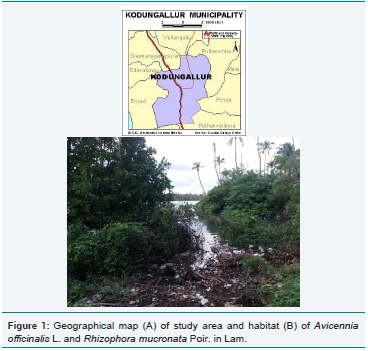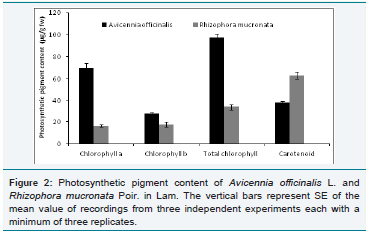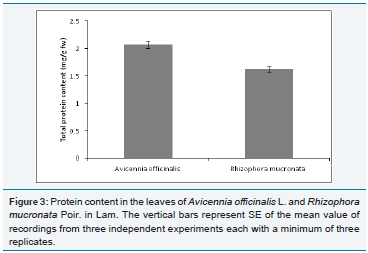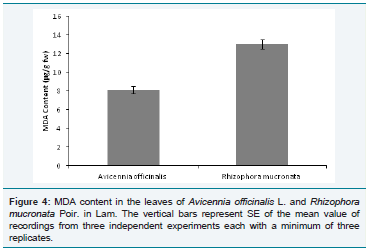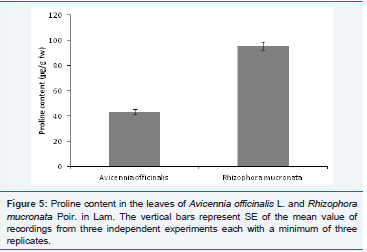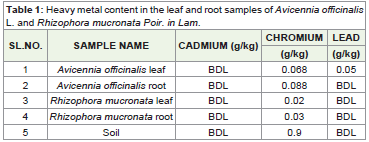Research Article
Heavy Metal Stress Tolerance Potential Evaluation of Two Halophytes - Avicennia officinalis L. and Rhizophora mucronata Poir. In Lam
Athira KV and Jisha KC*
Post Graduate Department of Botany, India
*Corresponding author: Jisha KC, Post Graduate Department of Botany, MES Asmabi College, P. Vemballur, Thrissur, Kerala-680671, India, Telephone: +91-9846514038; E-mail: jishakc123@gmail.com
Copyright: © Athira KV, et al. 2020. This is an open access article distributed under the Creative Commons Attribution License, which permits unrestricted use, distribution, and reproduction in any medium, provided the original work is properly cited.
Article Information: Submission: 25/04/2020; Accepted: 20/05/2020; Published: 27/05/2020
Abstract
Biotic and abiotic stresses exert a significant influence on the growth and reproduction of plants. Temperature, pH, light, water, salinity and various chemical pollutants are the important abiotic stresses which directly affect the survival, growth, reproduction and geographical distribution of all plants. The present study explains the heavy metal stress tolerance potential of two halophytes viz. Avicennia officinalis L. and Rhizophora mucronata Poir. in Lam. Physiological and biochemical assays were conducted on the plant and soil samples collected from the polluted areas of Kodungallur, Kerala. Results of the study indicated that A. officinalis L. shows better stress tolerance by accumulating low amount of proline and MDA and high amount of photosynthetic pigments which in turn allowed their better establishment in the polluted habitat. The phytoremediation potential was analysed by quantifying the heavy metals (Cr, Cd and Pb) from plant parts - root and leaf and also from the soil samples collected from their habitat. The assay indicated that the phytoremediation potential is higher in Avicennia officinalis L. and it was confirmed by the higher uptake of heavy metals by the plant when compared to that
of the Rhizophora mucronata Poir. in Lam. We recommends the use of halophyte Avicennia officinalis L. for the phytoremediation of polluted saline areas.
Keywords
Abiotic stress; Heavy metal stress; Chlorophyll; Proline; Carbohydrate
Introduction
Mangroves are the important group of plants occur on tropical and subtropical shorelines of all continents, where they are regularly exposed to saltwater inundation, low oxygen levels around their roots, and periodic tropical storms. Mangroves create unique ecological environments that host rich assemblages of species. The muddy or sandy sediments of the mangroves are the home to a variety of invertebrates, phytoplankton, zooplankton and fish. These mangroves may play a special role as nursery habitat for juveniles of fish whose
adults occupy other habitats (e.g. coral reefs and seagrass beds) [1]. Mangroves have developed complex morphological, anatomical, physiological, and molecular adaptations allowing the survival and success in their high-stress habitat [2]. These plants show number of adaptation such as pneumatophores, salt glands, salt exclusion and vivipary. They function in sediment trap provide protection to coral reefs from destruction. The local people collect food, timber and charcoal from mangrove forests [3].
The heavy metals in the polluted area are the major stress
factors in plants and this increased heavy metal concentration in
the environment is mainly due to human activities. Most of the
plants have the genetic ability to tolerate a wide range of stress for a
short duration. If the stress is prolonged, it may lead to plant death. Accumulation of heavy metals in natural ecosystems poses threats to
human health and biodiversity due to their persistence and toxicity.
Worldwide, coastal and marine ecosystems are subject to heavy
metal pollution from municipal wastes and runoffs from agriculture
and industrial sources. Exposure to heavy metals is a common
phenomenon due to their environmental pervasiveness [4]. Coastal
vegetation plays a major role in trapping and storing these pollutants.
Some researchers have already reported the importance of mangrove
ecosystems in trapping and storing heavy metals in sediments and
plant tissues. Thus undoubtedly, mangrove trees proportionally
contribute to heavy metal sequestration in their system.
Plants respond differently to various stresses. In the present
research work, the efficiency of two halophytes was compared for
their stress tolerance potential especially for the heavy metal stress.
The species selected for the study include Avicennia officinalis L. and
Rhizophora mucronata Poir. in Lam. The present study was framed
with the objective of comparing the various biochemical parameters
and quantification of heavy metals [Chromium (Cr), Lead (Pb) and
Cadmium (Cd)] in the leaves and roots of the selected halophytes and
soil.
Materials and Methods
Materials:
Plant material: Two halophytes Avicennia officinalis L. (Avicenniaceae) and Rhizophora mucronata Poir. in Lam. (Rhizophoraceae) were selected for the study. The plants were collected from mangroves swamps of Kodungallur municipality, Thrissur, Kerala, India. These areas showed high level of pollution and the main source of pollution is wastes from nearby city (Figure 1A and 1B).Methods:
Sample collection and prepapration: For the analysis of biochemical parameters, from the selected plants, 5th leaves from
the tip of branches were collected randomly from the study area. The
leaves were thoroughly washed in running tap water and the water
was blotted with the blotting paper. Estimation of physiological and
biochemical experiments were performed immediately after collection
and were repeated three times. To quantify heavy metals, the leaves
and roots of the halophytes were collected from different plants from
the study area and soil from their habitat was also collected and then
kept in the polythene bag separately. For heavy metal analysis, the
plant samples (leaves and roots) along with the soil sample washed
with distilled water, oven-dried at 60 oC till constant weight, and then
ground and stored.
Figure 1: Geographical map (A) of study area and habitat (B) of Avicennia officinalis L. and Rhizophora mucronata Poir. in Lam.
Physiological and Biochemical analysis:
Estimation of chlorophyll and carotenoids were carried according
to the method of Arnon [5]. The total carbohydrate content was
estimated by the method suggested by Sadasivam and Manickam and
total protein content of the plant material was estimated using Folin-
Ciocatteau reagent [6,7]. Proline and MDA content in the samples
was estimated according to standard protocols [8,9].For the heavy metal quantification, the root and leaf tissues of halophytes and also the soil around them were sampled and were dried at 60 oC in a hot air oven. Known weight of the dried sample were digested by refluxing in 10:4 ratio of Nitric acid and perchloric acid until the solution become colourless using Kjeldahl’s flask heated
in a sand bath. Then the digest was transferred to a standard flask and volume was made up to 50 ml and kept in screw capped containers. Atomic absorption spectrophotometer (ICPOES Optima 8000) was used for the estimation of heavy metals present in the digested samples.
Statistical analysis:
The results were analysed by using Microsoft excel. Standard deviation and standard error were determined for each category of data.Results
Photosynthetic pigments:
The perusal of data indicated that chlorophyll a and chlorophyll
b content of Acicennia officinalis were higher than of Rhizhophora
mucronata. The chlorophyll a (69.9 μg/g fw) was higher compared to
chlorophyll b (27.41 μg/g fw). Subsequently, total chlorophyll content
of Avicennia officinalis and Rhizophora mucronata was also varied
and it was higher in A. officinalis (97.15 μg/g fw) compared with
R. mucronata (33.46 μg/g fw) (Figure 2). Whereas, the carotenoid
content was higher in R. mucronata (63.84 μg/g fw) ompared with
that of Avicennia officinalis (38.46 μg/g fw). The of carotenoid content
of Avicennia was approximately half of that of Rhizophora (Figure 2).Protein:
Comparison of total protein content indicated a higher
concentration in the A. officinalis (2.07mg/g fw) than R. mucronata
(1.62 mg/g fw) (Figure 3).Malondialdehyde:
Malondialdehyde (MDA) is the final product of plant cell membrane lipid peroxidation and is one important sign of membrane
system injury. The MDA content was highest in R. mucronata (13.03
μg/g fw) compared with that of A. officinalis (8.11 μg/g fw) (Figure 4).Proline:
A higher amount of proline was present in the R. mucronata
(95.56 μg/g fw) than in A. officinalis (43.34 μg/g fw). From the results,
it was clear that there was a large difference between the amount of
proline present in Avicennia officinalis and Rhizophora mucronata
(Figure 5).
Figure 2: Photosynthetic pigment content of Avicennia officinalis L. and
Rhizophora mucronata Poir. in Lam. The vertical bars represent SE of the
mean value of recordings from three independent experiments each with a
minimum of three replicates.
Figure 3: Protein content in the leaves of Avicennia officinalis L. and Rhizophora
mucronata Poir. in Lam. The vertical bars represent SE of the mean value of
recordings from three independent experiments each with a minimum of three
replicates.
Figure 4: MDA content in the leaves of Avicennia officinalis L. and Rhizophora
mucronata Poir. in Lam. The vertical bars represent SE of the mean value of
recordings from three independent experiments each with a minimum of three
replicates.
Figure 5: Proline content in the leaves of Avicennia officinalis L. and Rhizophora
mucronata Poir. in Lam. The vertical bars represent SE of the mean value of
recordings from three independent experiments each with a minimum of three
replicates.
Heavy metal content:
The root and leaf samples of Avicennia officinalis and Rhizophora
mucronata and the soil collected from their habitat were tested
for the presence of heavy metals Cd, Cr and Pb. Among the heavy
metals, cadmium was below detectable level in all the samples. Lead
was found only in the leaves of A. officinalis (0.05 g/kg). The heavy
metal chromium was traceable in in all five samples. The soil sample
contained the highest amount of Cr (0.9 g/kg). The chromium was
high in the leaf of A. officinalis (0.068 g/kg). Comparison of the
chromium content of roots of indicated a higher that it was high in
the roots of A. officinalis (0.0875 g/kg). The result also showed that
the efficient heavy metal uptake was carried out by A. officinalis When
made a comparison between the amount of Chromium present in
the soil and leaf and root sample of two halophytes, it was found to
be high in soil sample (0.9) then in the root of Avicennia officinalis
(0.0875)>leaf of Avicennia officinalis (0.068)>root of Rhizophora
mucronata (0.03)>leaf of Rhizophora mucronata (0.0225) (Table 1).Discussion
The present study compared the stress tolerance potential of two halophytes namely A. officinalis and R. mucronata. Results of the study indicated that under stress conditions, the rate of production of both chlorophyll pigments, chlorophyll a and chlorophyll b was lower in R. mucronata compared to A. officinaalis. It was obvious that the stress exerted a significant effect on photosynthetic efficiency. That is why, under stress condition the total chlorophyll production is decreased in R. mucronata. This is in conformity with many studies on the effects of chlorophyll under different stressed conditions. A decrease in chlorophyll content was observed as a result of the increasing salt concentration in walnut [10]. In the mangrove, Bruguiera parviflora of the family Rhizophoraceae, NaCl has a limiting effect on photochemistry that ultimately affects photosynthesis by inhibiting
chlorophyll synthesis [11].
Table 1: Heavy metal content in the leaf and root samples of Avicennia officinalis
L. and Rhizophora mucronata Poir. in Lam.
The MDA content was higher in Rhizophora mucronata compared
to Avicennia officinalis. The increased MDA indicate that the plants
were under stressed condition. Studies showed that Malondialdehyde
content shows an increasing trend with increasing heavy metal
concentration in Bruguiera cylindrica [12]. Proline content also was
higher in R. mucronata. Increase in the proline content in plants also
indicates stressed nature of the plants. Due to the stress conditions
of Rhizophora mucronata they produced higher amount of proline.
Similar to our study, the leaf proline content decreased with increase
in salinity in Bruguiera parviflora [13]. Studies showed that proline
content increases with increasing NaCl concentration [12]. A
considerable and proportionate increase in proline content was
recorded with increase in the concentrations of heavy metals [14].
The total protein content of in R. mucronata and A. officinalis
also was compared. The total protein content were highest in the A.
officinalis than R. mucronata. There was a significant difference in the
amount of total protein content of these two halophytes. The studies
in Bruguiera parviflora also reported the accumulation of protein with
increasing level of salinity [11]. LEA (late embryogenesis abundant)
proteins in both plants and animals are associated with tolerance to
water stress resulting from desiccation and cold shock [15].
In our study, the highest amount of heavy metals was found
in the samples of A. officinalis than R. mucronata. Among the
heavy metals Pb was only found in the leaf sample of A. officinalis.
Moreover, A. officinalis, showed the highest amount of Cadmium
than R. mucronata. Similarly in the root sample also highest amount
of Chromium was found in the root of A. officinalis rather than in
R. mucronata. The studies on the heavy metal content of mangrove
flora in the Kerala coast showed that Cu, Zn and Pb were found to be
in higher concentrations in Avicennia officinalis [17]. In a mangrove
forest in Pattani Bay, Thailand, rhizosphere soil and leaf, stem and
root tissue from various plant species were tested for concentrations
of Cd, Cr, Cu, Mn, Ni, Pb and Zn. Of these metals, Pb concentrations
in the mangrove sediment found to be high [17].
Conclusion
In the present research work, the Avicennia officinalis and
Rhizophora mucronata were collected from the same localities. Due
to urban waste disposal into the study area collected localities. The
present study revealed that Avicennia officinalis were well established
under polluted habitats than Rhizophora mucronata. It was evident
from the physiological and biochemical parameters studied. The total
chlorophyll content was found to be higher in Avicennia officinalis
which indicate that these plants efficiently photosynthesis under
such harsh conditions and their metabolisms are not hindered by
the stressed habitat. The lower amount of MDA again confirms it.
The study also showed that Rhizophora mucronata respond stress by
producing more proline and we clearly understand that these plants
are more stressed than Avicennia officinalis, because the MDA content
was found to be high in Rhizophora mucronata. The quantification of heavy metals showed that the phytoremediation potential is also
high for Avicennia officinalis when compared to that of Rhizophora
mucronata. Avicennia officinalis absorbed more amount of heavy
metals than Rhizophora mucronata. That means Avicennia officinalis
plays an important role in the phytoremediation of heavy metals from
their habitat because they can absorb more heavy metals from their
polluted environment. The present study revealed that the Avicennia
officinalis can use for the phytoremediation of heavy metals from
the polluted habitat through their uptake they can reduce the
concentration of heavy metals in their habitat. From the results of
the present study it was concluded that Avicennia officinalis is more
stress tolerant than Rhizophora mucronata and the phytoremediation
potential was also found to be high in Avicennia officinalis.

